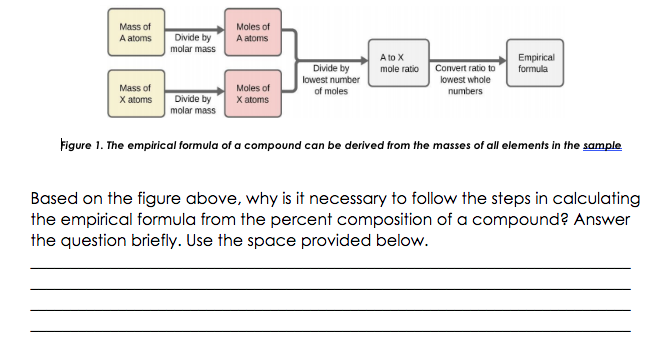Moles of Mass of A atoms Divide by molar mass A atoms A to X Divide by mole ratio Convert ratio to Empirical formula lowest number lowest whole Mass of Moles of X atoms of moles numbers X atoms Divide by molar mass Figure 1. The empirical formula of a compound can be derived from the masses of all elements in the sample Based on the figure above, why is it necessary to follow the steps in calculating the empirical formula from the percent composition of a compound? Answer the question briefly. Use the space provided below.
Moles of Mass of A atoms Divide by molar mass A atoms A to X Divide by mole ratio Convert ratio to Empirical formula lowest number lowest whole Mass of Moles of X atoms of moles numbers X atoms Divide by molar mass Figure 1. The empirical formula of a compound can be derived from the masses of all elements in the sample Based on the figure above, why is it necessary to follow the steps in calculating the empirical formula from the percent composition of a compound? Answer the question briefly. Use the space provided below.
Chemistry: Matter and Change
1st Edition
ISBN:9780078746376
Author:Dinah Zike, Laurel Dingrando, Nicholas Hainen, Cheryl Wistrom
Publisher:Dinah Zike, Laurel Dingrando, Nicholas Hainen, Cheryl Wistrom
Chapter11: Stoichiometry
Section: Chapter Questions
Problem 64A
Related questions
Question

Transcribed Image Text:Mass of
Moles of
A atoms
Divide by
A atoms
molar mass
A to X
Empirical
formula
Divide by
lowest number
mole ratio
Convert ratio to
lowest whole
Mass of
Moles of
of moles
numbers
X atoms
Divide by
molar mass
X atoms
Figure 1. The empirical formula of a compound can be derived from the masses of all elements in the sample
Based on the figure above, why is it necessary to follow the steps in calculating
the empirical formula from the percent composition of a compound? Answer
the question briefly. Use the space provided below.
Expert Solution
This question has been solved!
Explore an expertly crafted, step-by-step solution for a thorough understanding of key concepts.
Step by step
Solved in 2 steps with 1 images

Knowledge Booster
Learn more about
Need a deep-dive on the concept behind this application? Look no further. Learn more about this topic, chemistry and related others by exploring similar questions and additional content below.Recommended textbooks for you

Chemistry: Matter and Change
Chemistry
ISBN:
9780078746376
Author:
Dinah Zike, Laurel Dingrando, Nicholas Hainen, Cheryl Wistrom
Publisher:
Glencoe/McGraw-Hill School Pub Co

Principles of Modern Chemistry
Chemistry
ISBN:
9781305079113
Author:
David W. Oxtoby, H. Pat Gillis, Laurie J. Butler
Publisher:
Cengage Learning

Chemistry by OpenStax (2015-05-04)
Chemistry
ISBN:
9781938168390
Author:
Klaus Theopold, Richard H Langley, Paul Flowers, William R. Robinson, Mark Blaser
Publisher:
OpenStax

Chemistry: Matter and Change
Chemistry
ISBN:
9780078746376
Author:
Dinah Zike, Laurel Dingrando, Nicholas Hainen, Cheryl Wistrom
Publisher:
Glencoe/McGraw-Hill School Pub Co

Principles of Modern Chemistry
Chemistry
ISBN:
9781305079113
Author:
David W. Oxtoby, H. Pat Gillis, Laurie J. Butler
Publisher:
Cengage Learning

Chemistry by OpenStax (2015-05-04)
Chemistry
ISBN:
9781938168390
Author:
Klaus Theopold, Richard H Langley, Paul Flowers, William R. Robinson, Mark Blaser
Publisher:
OpenStax

Introductory Chemistry: A Foundation
Chemistry
ISBN:
9781337399425
Author:
Steven S. Zumdahl, Donald J. DeCoste
Publisher:
Cengage Learning


World of Chemistry, 3rd edition
Chemistry
ISBN:
9781133109655
Author:
Steven S. Zumdahl, Susan L. Zumdahl, Donald J. DeCoste
Publisher:
Brooks / Cole / Cengage Learning